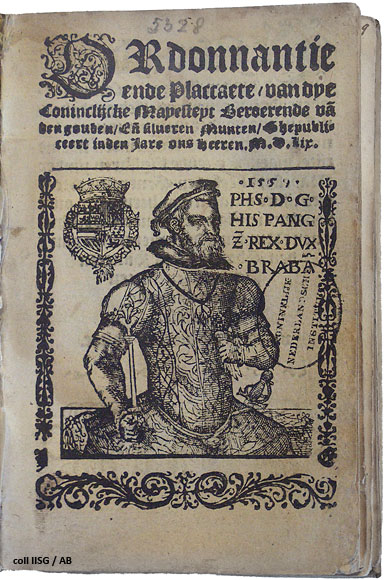
Ordonnantie ende Placcaete van dye Conincklijke Mayesteyt beroerende van den gouden ende silveren Munten.
[Aemstelredam] : [Jan Ewoudt zoon],
1559
Call number:
AB E 5328
Beeldenaars were booklets or albums in which current legal coins were pictured, together with indications of their conversion rates, to which often lists of current, but no longer valid coins were added. Before the nineteenth century, the actual coinage in circulation was often so confusing that the public sorely needed this type of handy guide. This type of publication, of which the oldest extant one was printed at the end of the fifteenth century in the Southern Netherlands, especially Antwerp, is clearly of enormous interest because it provides some insight into the circulation of coins and is necessary for interpreting wage and price information (see also: www.iisg.nl/hpw).
Beginning in the 1920s, Professor Posthumus, founder of the Netherlands Economic-Historical Archive/Economic History Library was already looking for this type of documents, and he also acquired various ones for NEHA/EHB, including a small bundle of three Amsterdam beeldenaars from 1558, 1559, and 1560, all published by Jan Ewoutszoon, sculptor and book publisher in Amsterdam from 1531 to 1561.
The KNAW copy is also comprised of three editions (from 1559, 1566 and 1568) from the same book printer's studio, but - and here is where it becomes interesting - each individual piece varies from the NEHA/EHB group that was already present. Thus, it puts us in a better position to follow closely the circulation of coins just before the revolt. Of course, this requires very careful comparison, image by image.
The only other similarly large collection of this type of publications exists in the newly established Geldmuseum (Money Museum) in Utrecht.
Beginning in the 1920s, Professor Posthumus, founder of the Netherlands Economic-Historical Archive/Economic History Library was already looking for this type of documents, and he also acquired various ones for NEHA/EHB, including a small bundle of three Amsterdam beeldenaars from 1558, 1559, and 1560, all published by Jan Ewoutszoon, sculptor and book publisher in Amsterdam from 1531 to 1561.
The KNAW copy is also comprised of three editions (from 1559, 1566 and 1568) from the same book printer's studio, but - and here is where it becomes interesting - each individual piece varies from the NEHA/EHB group that was already present. Thus, it puts us in a better position to follow closely the circulation of coins just before the revolt. Of course, this requires very careful comparison, image by image.
The only other similarly large collection of this type of publications exists in the newly established Geldmuseum (Money Museum) in Utrecht.
